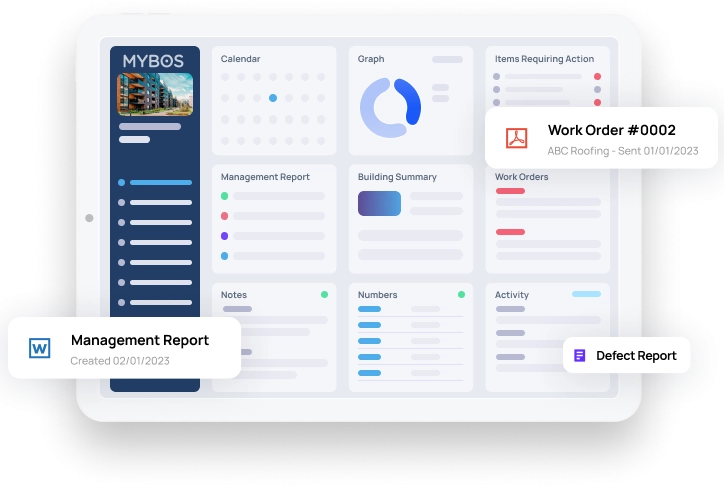
6 Common Challenges in Commercial Property Management and How to Solve Them
From tenant complaints to budget overruns, commercial property management can feel like a constant juggling act. Each challenge—whether it’s maintenance issues or tech adoption—can create operational bottlenecks that impact tenant satisfaction and building performance.
In a recent report by Deloitte, property leaders highlighted rising maintenance costs and operational inefficiencies as key pain points in commercial buildings, along with growing pressure from market disruptions, sustainability compliance, and technology integration.
Whether you manage office buildings, retail centres, or mixed-use developments, understanding the most common pain points can help you take a more proactive approach.
In this article, we explore six top challenges in commercial property management—and the proven strategies to resolve them effectively.
1. Maintenance Challenges in Commercial Properties
Unplanned maintenance issues and inefficient repair workflows can disrupt operations, increase costs, and frustrate tenants. A reactive approach often leads to recurring problems and avoidable downtime.
Examples:
- A broken HVAC system in a retail complex takes days to repair due to unclear vendor responsibilities and no tracking system.
- Routine inspections are missed, leading to a roof leak that damages multiple tenant spaces.
To avoid these situations, property managers can adopt a facilities management platform that automates preventive maintenance schedules and keeps track of asset history. Digital work order systems can streamline the process of assigning and resolving repair requests, helping teams respond more efficiently. Mobile reporting tools also enable onsite staff to log issues immediately, reducing delays and ensuring problems are addressed promptly.
2. Tenant Management in Commercial Buildings
Managing relationships with multiple commercial tenants—each with unique needs, lease terms, and expectations—requires careful coordination and a tenant-first mindset.
Examples:
- A tenant regularly complains about noise disruptions but doesn’t feel heard due to lack of a formal feedback or request channel.
- Confusion over access control or shared facility bookings leads to tenant disputes.
A dedicated tenant portal or mobile app allows tenants to submit service requests, report concerns, and receive timely updates—all in one place. Keeping digital records of interactions builds transparency and ensures accountability. Automated reminders for tenant milestones like lease renewals, inspections, or maintenance visits also help prevent miscommunication and build trust.
Learn more about what a commercial property manager does to help maintain strong tenant relationships and improve service delivery.
3. Commercial Lease Management Issues
Tracking complex lease agreements, key dates, and compliance obligations manually can lead to costly oversights and legal risk. PwC notes that manual lease data tracking often leads to errors in clause reconciliation, missed term dates, and difficulty complying with tax and accounting standards.
Examples:
- A property manager misses a lease renewal deadline, resulting in revenue loss and an unexpected vacancy.
- Disputes arise due to outdated or missing documentation on rent escalation clauses.
Centralising lease documentation in a cloud-based management system helps ensure key information is always accessible and secure. Automated alerts for lease expirations, rent reviews, and compliance deadlines allow property managers to stay ahead of critical dates. Additionally, digital dashboards offer quick access to lease summaries and occupancy data, making it easier to manage multiple leases at once.
4. Vendor Coordination for Property Managers
Managing third-party contractors—such as cleaners, landscapers, electrical repairs and security—is a common logistical challenge, especially across multiple sites or buildings.
Examples:
- A cleaning vendor fails to show up, but the manager doesn’t find out until tenants complain the next day.
- Work orders are issued via email or phone, creating confusion about timelines and accountability.
Vendor management tools enables managers to assign tasks, monitor performance, and store essential compliance documents like licenses and insurance. Some platforms also support digital check-ins or GPS-based verification to confirm service completion. Maintaining a central database of preferred vendors, complete with service history and ratings, makes it easier to choose reliable contractors for future jobs.
Read more about whether outsourcing or keeping your teams in-house is right for your property.
5. Reducing Operating Costs in Commercial Real Estate
Rising utility bills, inefficient processes, and lack of financial visibility can quickly wear down a property’s long-term profitability.
Examples:
- Energy usage spikes due to inefficient HVAC systems, but no monitoring tools are in place to detect or address it.
- Overlapping service contracts and duplicated tasks go unnoticed due to siloed cost management.
Energy management tracking can help track usage trends and identify areas of waste, allowing property managers to make smarter, data-driven improvements. Integrated budgeting tools also provide visibility into operating costs, enabling more accurate forecasting and cost control. Conducting regular contract reviews and vendor audits can further help eliminate redundancies and uncover opportunities to negotiate better service rates.
McKinsey research in retail and building optimisation shows that energy-saving technologies, especially for lighting and HVAC, can reduce utility costs by 20–30%, while operational changes like optimised lighting schedules contribute a further 2–5% savings. The same principles can easily be applied to commercial properties.
6. Improving Communication with Tenants
Clear, timely communication is essential to building trust and ensuring smooth property operations—but many commercial properties still rely on manual or fragmented channels.
Examples:
- Tenants aren’t informed about upcoming maintenance work, resulting in business disruptions.
- Important updates (like policy changes or emergency alerts) are sent via email and go unread.
Mass notification or ‘broadcast’ tools and tenant experience apps allow managers to communicate updates, notices, and emergency alerts in real time. A digital tenant hub can serve as a central location for announcements, policy documents, and FAQs, making it easier for tenants to access key information. Additionally, using automated templates for routine messages—such as rent reminders or inspection notices—ensures consistent communication across all tenants.
Key Takeaways: Staying Ahead in a Complex Property Landscape
Commercial property management is complex, but these common challenges can be effectively addressed with the right systems and strategies. Investing in reliable, scalable software not only improves daily operations but enhances long-term tenant retention, vendor relationships, and profitability.
Implementing a smart system streamlines communication, simplifies vendor coordination, and improves lease and asset visibility. It lightens daily workloads while boosting tenant satisfaction, reducing risk, and enhancing operational continuity.
At the end of the day, success in managing commercial properties comes down to control, clarity, and connection. The right software partner empowers you with all three.
Want to see how a smart platform can transform the way you manage commercial real estate? Book a demo with MYBOS today to explore how our features are designed specifically to solve real-world property management problems.




